
The crown-of-thorns starfish, Acanthaster planci, is a large starfish that preys upon hard, or stony, coral polyps (Scleractinia). The crown-of-thorns starfish receives its name from venomous thorn-like spines that cover its upper surface, resembling the biblical crown of thorns. It is one of the largest starfish in the world.

The bicolor angelfish is a marine species of fish, easily recognizable by its yellow tail, yellow front half of their body, and blue rear with blue patterns above and around the eye. Other names of this angelfish include: Pacific rock beauty, oriole angelfish, oriole dwarf angel, blue and gold angel, and two-colored angel. The life expectancy of this fish in the wild varies greatly, depending on location, and ranges between 5 and 13 years. These fish tend to grow to a maximum of 6 inches in length. The larval stages lasts approximately 32 days.

Linckia laevigata is a species of sea star in the shallow waters of tropical Indo-Pacific.
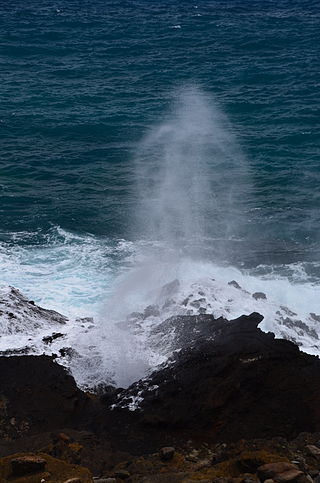
Hālona Blowhole is a rock formation and a blowhole on the island of Oahu, Hawaii off of Hanauma Bay at Hālona Point overlooking the Pacific Ocean. In Hawaiian hālona means "lookout".
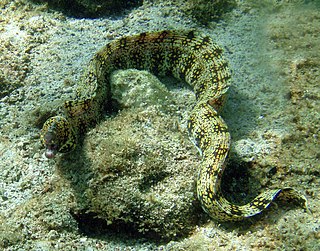
The snowflake moray, also known as the clouded moray among many vernacular names, is a species of marine eel of the family Muraenidae. It has blunt teeth ideal for its diet of crustaceans, a trait it shares with the zebra moray.
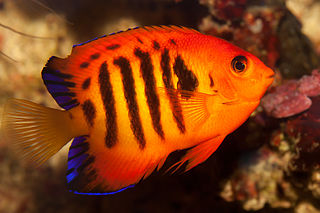
The flame angelfish is a marine angelfish of the family Pomacanthidae found in tropical waters of the Pacific Ocean. Other common names include flame angel, flaming angelfish and Japanese pygmy angelfish.

Nemateleotris magnifica, known by a variety of common names including fire goby, magnificent fire fish, fire dartfish, or red fire goby, is a species of dartfish native to coral reefs of the Indian and Pacific oceans.
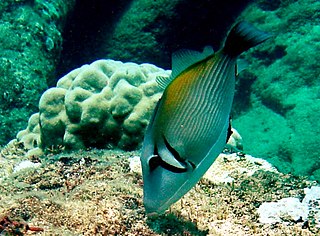
Sufflamen bursa, sometimes known as Lei Triggerfish, bursa triggerfish, scythe triggerfish or boomerang triggerfish, is a triggerfish from the Indo-Pacific. Its name is derived from the two markings behind its eyes that wrap around the fish similar to a Hawaiian Lei. The color of these markings changes depending on the fish's mood, in which case the colors may alter from yellow, dark brown, and black. It is a species of reef fish found in reef ecosystems in the Indo-Pacific, including Japan, Australia, and Hawaii. It occasionally makes its way into the aquarium trade.

Cassis cornuta, common name the horned helmet, is a species of extremely large sea snail, a marine gastropod mollusc in the family Cassidae, the helmet shells and their allies.
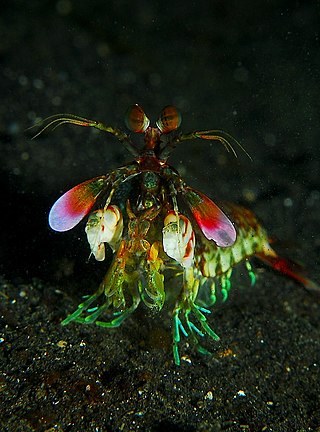
Gonodactylus smithii, also known as the purple spot mantis shrimp or Smith's mantis shrimp, is a species of the smasher type of mantis shrimp. G. smithii are the first animals discovered to be capable of dynamic polarization vision. They are identified by their distinctive meral spots ranging from maroon to purple with a white ring, though those that inhabit depths below 10 meters tend to be colored maroon. They also have raptorial dactyles, specialized forelimbs that are pigmented green and red, and antennal scales that are yellow.

Linckia multifora is a variously colored starfish in the family Ophidiasteridae that is found in the Indian Ocean and Red Sea. Its common names include the Dalmatian Linckia, mottled Linckia, spotted Linckia, multicolor sea star and multi-pore sea star.

Porites lobata, known by the common name lobe coral, is a species of stony coral in the family Poritidae. It is found growing on coral reefs in tropical parts of the Indian and Pacific Oceans.

Nemateleotris helfrichi, Helfrich's Dartfish, is a species of dartfish native to the Pacific Ocean.

Due to the warming of the Atlantic Ocean caused by climate change, many species of fish are beginning to shift north towards cooler waters within their temperature range. Tropical species are being found outside their normal range and into more northern waters causing an array of ecological, economic, and fishery management problems.

Pocillopora verrucosa, commonly known as cauliflower coral, rasp coral, or knob-horned coral, is a species of stony coral in the family Pocilloporidae. It is native to tropical and subtropical parts of the Indian and Pacific Oceans.
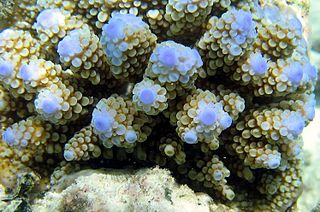
Acropora nasuta is a species of branching stony coral in the family Acroporidae. It is native to the western and central Indo-Pacific where it is found in shallow reef habitats. Like other corals of the genus Acropora, it is susceptible to coral bleaching and coral diseases and the IUCN has listed it as being "Near Threatened".

Novodinia antillensis, the velcro sea star, is a species of starfish in the family Brisingidae. It is found in the deep sea in the tropical and subtropical western Atlantic Ocean, being quite common at a depth of around 500 m (1,640 ft) on the Mesoamerican Reef off Roatán, Honduras.

Echinaster callosus, the warty sea star or the banded bubble star, is a species of starfish found in shallow parts of the western Indo-Pacific region. The disc and five slender arms are covered with white, pink, red or violet warts, often forming transverse bands of colour on the arms.

Cephalopholis sonnerati, known as the tomato hind, tomato rockcod, or tomato cod, is a species of marine ray-finned fish, a grouper from the subfamily Epinephelinae which is in the family Serranidae which also includes the anthias and sea basses. It is distributed on coral reefs in the tropical Indo-Pacific. It is also sometimes called the orange-spotted cod, red coral cod, red rockcod, tomato grouper, or tomato seabass.

Zenopontonia soror, the starfish shrimp or seastar shrimp, is a species of shrimp in the family Palaemonidae. It is found in shallow water in the tropical Indo-Pacific region. It lives in association with a starfish, often changing its colour to match that of its host.
























